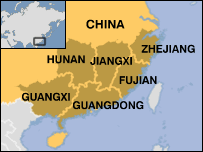With his flight out of Hong Kong due to leave within 27 hours the son of the family is somewhere in typhoon hit Jiangxi Province, on a bus journey scheduled to take around 12 hours at the best of times to Shenzen in Guandong Province near Hong Kong.
Torrential rain following the storm has hit Southern China hard bringing severe flooding and landslides which have forced millions to flee their homes.  A scene in Fuzhou, Fujian. Photos from the BBC.
A scene in Fuzhou, Fujian. Photos from the BBC. 
Shaoguan, Guandong
 Now missing the flight would be of little consequence compared to the misery of so many flood victims, but here's wishing that bus a safe road home.
Now missing the flight would be of little consequence compared to the misery of so many flood victims, but here's wishing that bus a safe road home.
Once one of the greatest shipbuilding rivers in the world, the Tyne is currently witnessing the death throes of the last major ship yard on its legendary waters.
Shipbuilders Swan Hunter have probably built their last ship following a government decision to remove two naval vessels for completion elsewhere because of massive cost overruns and time delays. The yard's future is now likely to lie in ship-breaking rather than ship-building. Famous ships such as the Mauretania, once the largest ship in the world and which held the coveted Blue Riband for the fastest Atlantic crossing, the Carpathia which rescued the survivors from the Titanic and HMS Ark Royal the current flagship of the Royal Navy were all built at their Wallsend yard.
In the early 1970s they produced several 'supertankers' which, during construction, towered over the adjacent terraced houses. (See pictures below by Norman Dunn. click to enlarge)


6 British soldiers have been killed in Afghanistan's volatile Helmand province in the last 4 weeks bringing into question why our troops are there and whether they can they succeed in their mission when it is by no means certain what their mission is.
History shows that foreign powers rarely prosper in remote Afghanistan and certainly not in the long-term as the once mighty Soviet Union learned to their cost.
One earlier British military success there occurred in September 1880 when Lieutenant General Sir Frederick Roberts led a force of 2,562 British and 7,151 Indian troops to relieve surviving troops from a defeat on 27 July by the Afghan ruler Ayub Khan at Maiwand; who were besieged in Kandahar 40 miles to the west . The relief force from Kabul reached Kandahar on 31st August 1880 and rescued the beleaguered defenders. Roberts had force marched his troops 300 miles, through hot and harsh terrain, in three weeks, a feat which entered the annals of army history.
Much later, in 1914, when Grandfather Charles Gordon was training with the Northumberland Fusiliers in Buckinghamshire he was billeted with a Mr Arnold and family in Chesham. One evening Grandad arrived back at the Arnold's complaining bitterly about a 20 mile route march he had completed that day. Mr Arnold, who was a veteran of that long march from Kabul, chided him; "Charlie" he said " that's nothing, you should have been on the march from Kabul to Kandahar." The British and Indian regiments were to finally withdraw from Afghanistan in 1881 following the Treaty of Gandamak whereby a large part of Afghan territory became part of India, including much mountainous tribal territory. 65 years of conflict between tribes there and the British and Indian armies followed. Roll forward to Helmund province, July 2006 where a small and underesourced British force is on a hiding to nothing.
"Those who ignore history are condemned to repeat it"
90 years ago today, at 07.30 hours, the Battle of the Somme began and by the end of the day 20,000 British and Empire soldiers had been killed and 40,000 wounded; amongst them coal miners from Northumberland, men from the slums of the East End of London, and the Prime Minister's son, Raymond Asquith of the Grenadier Guards. When the battle ended in November the British casualties numbered 420,000 dead, wounded and missing , the French more than 200,000 and the Germans around 650,000. Most of these men were from the industrial working classes whose pre-war lives would have had more in common with each other than with the politicians who led them into war and with the Generals who directed them into a maelstrom of futile and senseless slaughter in a landscape of unimaginable privation.My grandfather Charles Crow Gordon was at the Somme that day, serving as a signaller with the 14th Battalion of the Northumberland Fusiliers. Charles had volunteered in Newcastle upon Tyne in September 1914, finally returning home in 1918.
The photograph below shows my Grandfather Charles standing next to his comrade and friend Ernie. The photo was sent to Charles by Ernie on 24 August 1931 with the following words:
"Dear Charlie, ...... Hoping you are all well......thought this would bring memories of Arras, August 1916 after July 1 on the Somme, Yr old friend Ernie."


 click photos to enlarge
click photos to enlarge




